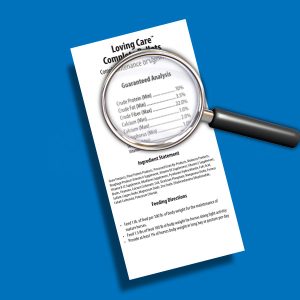
It’s on the Horse Feed Tag – Part 4
What does the guaranteed analysis really tell you?
If you have looked at a feed tag you have seen a guaranteed analysis (GA) of nutrients. It is full of minimums and maximums, crude this and that, and lots of numbers. But what does the GA really tell you about the feed you are considering for your horse? A lot!
The GA gives you a tremendous amount of information about the nutrients in the feed. Once you understand how to decipher the GA, it will be much easier to determine which feed is most appropriate for your horse.
Before you even begin to look at a guaranteed analysis on the feed tag you need to understand your horse’s nutritional requirements. As we discussed previously, they will depend on your horse’s life stage, how much exercise he or she is getting, and if they have any health issues. Horses receive nutrients from both the concentrate and forage portion of their ration. Concentrates are used to supply the additional nutrients and energy that forages do not provide. When choosing a concentrate, it is important to always take into consideration the nutrients delivered by the entire diet, not just one portion of it. Forages can easily be tested for nutrient content. If you are unsure of what your horse’s requirements are, consult with your veterinarian or equine nutritionist.
Most GAs will provide the levels of protein, fat, and fiber found in the feed. It also contains information about vitamins and minerals. In this section we will look at what crude protein, fat, and fiber tell you about the nutrients contained in a particular bag of feed.
Minimum percent crude protein:
The minimum % crude protein is the portion of the total weight of the feed that is composed of crude protein. Therefore, a 40-lb bag of 10% protein feed contains 4 lbs (40 x .10) of total protein. If you feed 5 pounds of feed per day, your horse is consuming (5 x .10) or .5 lbs of protein per day.
Horses need protein to maintain and develop muscle as well as other tissues in the body. It also plays a role in the production of enzymes and hormones. As horses mature, their protein requirements decrease. Young growing horses, mares in the late stages of pregnancy, and lactating mares require the highest levels of protein. The chart below will give you some general rules to follow for daily protein requirements.
| Age | % Protein |
|---|---|
| Weanling | 16% |
| Yearling | 14% |
| Pregnant Mare | 14% |
| Performance Horse – mature | 10%-12% |
| Maintenance Horse – mature | 9%-10% |
| Senior Horse | 12%-14% |
In the past, horsemen have often purchased a feed based strictly on the percentage of protein it contained, but we now know that energy is the most important factor to consider when purchasing a feed. So while the percentage of protein is an important number to review, it is not the only information used to choose the correct feed for your horse.
The percentage of protein contained in the feed should match the protein requirements of your horse at his specific life stage. The percentage of protein in commercial feeds ranges from 8% to 16%.
The quality of the protein in the feed is important, especially for growing horses. Lysine, an amino acid used to build protein in the body, is considered the first limiting amino acid. It must be present for a horse to build protein in his body, so it must be provided in the feed at the appropriate levels. Some feed companies will note the lysine levels in their feeds on the GA. The lysine requirement for a weanling is .65%; it drops to .45% for a yearling. (To learn more about protein, you can refer to the following KPP Nutritional Minutes: Myths and Facts about Protein and Protein Demystified.)
Minimum percent crude fat:
The percentage of crude fat is the portion of the total feed that is made up of fat. The higher the level of fat found in the feed, the more energy the feed contains. In fact, fat provides 2.5 times as much energy as either carbohydrates or proteins.
In order to meet a horse’s energy requirements, a feed that contains high fat can be fed in smaller amounts than one that contains low fat. Incorporating high-fat concentrates into the diet is beneficial when horses need large amounts of energy to do their jobs, or to grow. If you have an easy keeper you may want to steer clear of high-fat, high-energy feeds because they provide too many calories!
The percentage of fat found in commercial feeds ranges from:
- 1 % – 2% for feeds with no added fat
- 6% – 14% for feeds with added fat
Rice bran is a common fat source added to commercial feeds. (To learn more about the benefits of including fat in a horse’s diet you can refer to the following blog post: The Skinny on Fat.)
Maximum percent crude fiber:
It should be no surprise that the percentage of crude fiber is the portion of the total feed that is made up of fiber. Fiber is very important for the proper functioning of the equine digestive tract. The majority of the fiber in a horse’s diet comes from the forage portion of his or her ration and is in the form of hay or pasture.
The fiber found in feeds does provide some energy, but in a less digestible form than fats, carbohydrates, or protein. Fiber and energy are typically conversely related; in other words, as the fiber level goes up, the energy level goes down.
- Feeds with less than 7% fiber are energy dense and should be fed with care
- Concentrates containing 8% to 11% crude fiber supply moderate levels of energy
- Crude fiber percentages above 12% are considered low in energy
There are many sources of fiber added to feed; some are more digestible than others and will add more energy to a feed than others. We will talk about that further in the section about ingredients. (To learn more about fiber, refer to the following blog post: Fiber, the Key to Healthier Horses.)
Starch content
Another modern trend in concentrates is low-starch feeds. The most common number used to indicate the starch level in a feed is NSC (nonstructural carbohydrates, or starches plus sugars). Some manufacturers are starting to include NSC on their feed tags; however, it is not required.
- NSC levels of greater than 35% indicate a high-starch feed
- NSC of 20% to 35% is considered a moderate starch level
- NSC of less than 20% is low starch
Energy
One piece of important information that isn’t on most feed tags is the level of energy the concentrate will provide. Energy is the first thing you should consider when evaluating a feed; after all, it is what your horse needs to fuel all his bodily functions and power locomotion. Without adequate energy a horse will not be able to maintain his or her body weight and will be more susceptible to injury and illness.
Energy is not a nutrient, so there is no requirement for it to be listed on the feed tag. Fats, carbohydrates, proteins, and fiber all provide energy when incorporated into a feed. Determining the energy level of a specific feed is a complicated and expensive process, which is why only some feed tags contain this information. When the energy content is presented, it is listed in megacalories (Mcal) per a unit of weight.
There is a way to estimate the amount of energy a concentrate may contain when Mcals are not provided, and that is to look at the combination of percentage of crude fat and crude fiber.
Typically a high-fiber, low-fat feed will have less energy than a low-fiber, high-fat feed. Some feeds contain super fibers that are more digestible; this will increase the energy level of a feed (more on super fibers in the ingredients section).
It is increasingly common to find feeds that are high in both fat and fiber; their energy levels will vary depending on the fiber sources used and the percentages of fat and fiber included. Feeds that derive their energy from fat and fiber have been proven to be healthier than feeds that derive their energy from starch and sugar.
The guaranteed analysis also provides information about the vitamins and minerals contained in a commercial feed. This information is particularly important when determining the necessity of additional supplementation. More about that in part 5 of the “It’s on the Horse Feed Tag” series.


